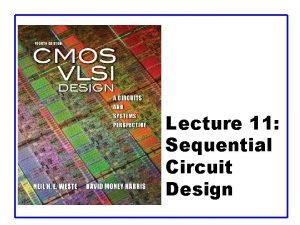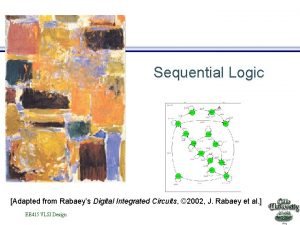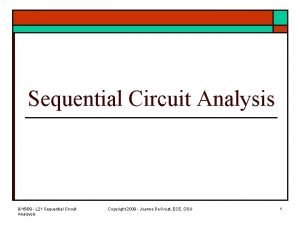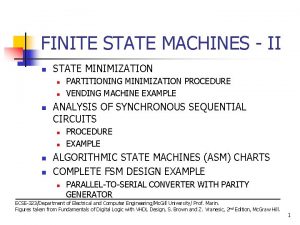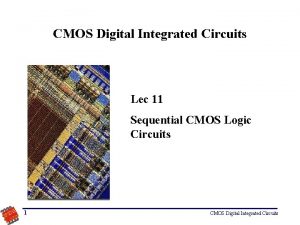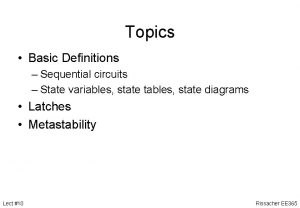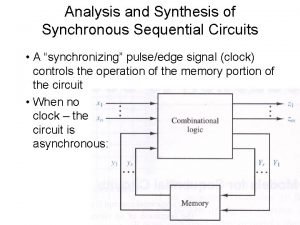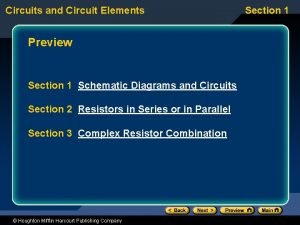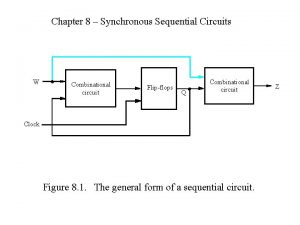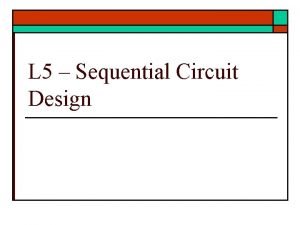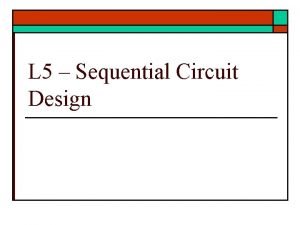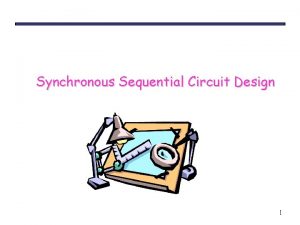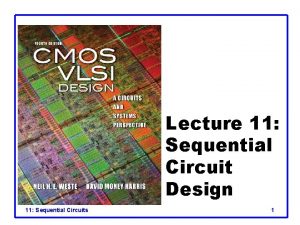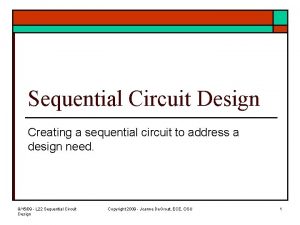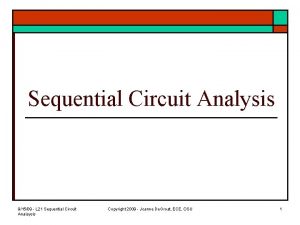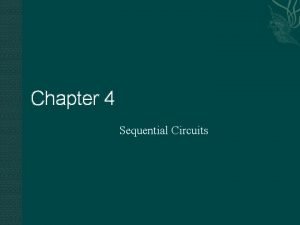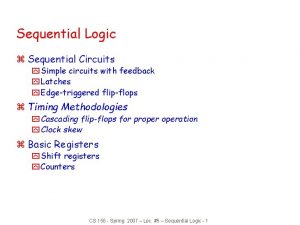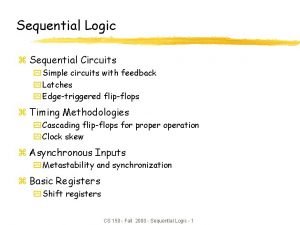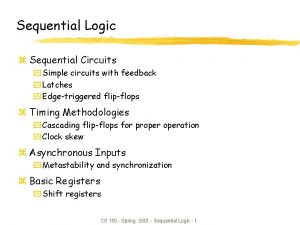Lecture 11 Sequential Circuit Design 11 Sequential Circuits



































- Slides: 35

Lecture 11: Sequential Circuit Design 11: Sequential Circuits 1

Outline q q q Sequencing Element Design Max and Min-Delay Clock Skew Time Borrowing Two-Phase Clocking 11: Sequential Circuits CMOS VLSI Design 4 th Ed. 2

Sequencing q Combinational logic – output depends on current inputs q Sequential logic – output depends on current and previous inputs – Requires separating previous, current, future – Called state or tokens – Ex: FSM, pipeline 11: Sequential Circuits CMOS VLSI Design 4 th Ed. 3

Sequencing Cont. q If tokens moved through pipeline at constant speed, no sequencing elements would be necessary q Ex: fiber-optic cable – Light pulses (tokens) are sent down cable – Next pulse sent before first reaches end of cable – No need for hardware to separate pulses – But dispersion sets min time between pulses q This is called wave pipelining in circuits q In most circuits, dispersion is high – Delay fast tokens so they don’t catch slow ones. 11: Sequential Circuits CMOS VLSI Design 4 th Ed. 4

Sequencing Overhead q Use flip-flops to delay fast tokens so they move through exactly one stage each cycle. q Inevitably adds some delay to the slow tokens q Makes circuit slower than just the logic delay – Called sequencing overhead q Some people call this clocking overhead – But it applies to asynchronous circuits too – Inevitable side effect of maintaining sequence 11: Sequential Circuits CMOS VLSI Design 4 th Ed. 5

Sequencing Elements q Latch: Level sensitive – a. k. a. transparent latch, D latch q Flip-flop: edge triggered – A. k. a. master-slave flip-flop, D register q Timing Diagrams – Transparent – Opaque – Edge-trigger 11: Sequential Circuits CMOS VLSI Design 4 th Ed. 6

Latch Design q Pass Transistor Latch q Pros + Tiny + Low clock load q Cons – Vt drop – nonrestoring – backdriving – output noise sensitivity – dynamic – diffusion input 11: Sequential Circuits CMOS VLSI Design 4 th Ed. Used in 1970’s 7

Latch Design q Transmission gate + No Vt drop - Requires inverted clock 11: Sequential Circuits CMOS VLSI Design 4 th Ed. 8

Latch Design q Inverting buffer + Restoring + No backdriving + Fixes either • Output noise sensitivity • Or diffusion input – Inverted output 11: Sequential Circuits CMOS VLSI Design 4 th Ed. 9

Latch Design q Tristate feedback + Static – Backdriving risk q Static latches are now essential because of leakage 11: Sequential Circuits CMOS VLSI Design 4 th Ed. 10

Latch Design q Buffered input + Fixes diffusion input + Noninverting 11: Sequential Circuits CMOS VLSI Design 4 th Ed. 11

Latch Design q Buffered output + No backdriving q Widely used in standard cells + Very robust (most important) - Rather large - Rather slow (1. 5 – 2 FO 4 delays) - High clock loading 11: Sequential Circuits CMOS VLSI Design 4 th Ed. 12

Latch Design q Datapath latch + smaller + faster - unbuffered input 11: Sequential Circuits CMOS VLSI Design 4 th Ed. 13

Flip-Flop Design q Flip-flop is built as pair of back-to-back latches 11: Sequential Circuits CMOS VLSI Design 4 th Ed. 14

Enable q Enable: ignore clock when en = 0 – Mux: increase latch D-Q delay – Clock Gating: increase en setup time, skew 11: Sequential Circuits CMOS VLSI Design 4 th Ed. 15

Reset q Force output low when reset asserted q Synchronous vs. asynchronous 11: Sequential Circuits CMOS VLSI Design 4 th Ed. 16

Set / Reset q Set forces output high when enabled q Flip-flop with asynchronous set and reset 11: Sequential Circuits CMOS VLSI Design 4 th Ed. 17

Sequencing Methods q Flip-flops q 2 -Phase Latches q Pulsed Latches 11: Sequential Circuits CMOS VLSI Design 4 th Ed. 18

Timing Diagrams Contamination and Propagation Delays tpd Logic Prop. Delay tcd Logic Cont. Delay tpcq Latch/Flop Clk->Q Prop. Delay tccq Latch/Flop Clk->Q Cont. Delay tpdq Latch D->Q Prop. Delay tcdq Latch D->Q Cont. Delay tsetup Latch/Flop Setup Time thold Latch/Flop Hold Time 11: Sequential Circuits CMOS VLSI Design 4 th Ed. 19

Max-Delay: Flip-Flops 11: Sequential Circuits CMOS VLSI Design 4 th Ed. 20

Max Delay: 2 -Phase Latches 11: Sequential Circuits CMOS VLSI Design 4 th Ed. 21

Max Delay: Pulsed Latches 11: Sequential Circuits CMOS VLSI Design 4 th Ed. 22

Min-Delay: Flip-Flops 11: Sequential Circuits CMOS VLSI Design 4 th Ed. 23

Min-Delay: 2 -Phase Latches Hold time reduced by nonoverlap Paradox: hold applies twice each cycle, vs. only once for flops. But a flop is made of two latches! 11: Sequential Circuits CMOS VLSI Design 4 th Ed. 24

Min-Delay: Pulsed Latches Hold time increased by pulse width 11: Sequential Circuits CMOS VLSI Design 4 th Ed. 25

Time Borrowing q In a flop-based system: – Data launches on one rising edge – Must setup before next rising edge – If it arrives late, system fails – If it arrives early, time is wasted – Flops have hard edges q In a latch-based system – Data can pass through latch while transparent – Long cycle of logic can borrow time into next – As long as each loop completes in one cycle 11: Sequential Circuits CMOS VLSI Design 4 th Ed. 26

Time Borrowing Example 11: Sequential Circuits CMOS VLSI Design 4 th Ed. 27

How Much Borrowing? 2 -Phase Latches Pulsed Latches 11: Sequential Circuits CMOS VLSI Design 4 th Ed. 28

Clock Skew q We have assumed zero clock skew q Clocks really have uncertainty in arrival time – Decreases maximum propagation delay – Increases minimum contamination delay – Decreases time borrowing 11: Sequential Circuits CMOS VLSI Design 4 th Ed. 29

Skew: Flip-Flops 11: Sequential Circuits CMOS VLSI Design 4 th Ed. 30

Skew: Latches 2 -Phase Latches Pulsed Latches 11: Sequential Circuits CMOS VLSI Design 4 th Ed. 31

Two-Phase Clocking q If setup times are violated, reduce clock speed q If hold times are violated, chip fails at any speed q In this class, working chips are most important – No tools to analyze clock skew q An easy way to guarantee hold times is to use 2 phase latches with big nonoverlap times q Call these clocks f 1, f 2 (ph 1, ph 2) 11: Sequential Circuits CMOS VLSI Design 4 th Ed. 32

Safe Flip-Flop q Past years used flip-flop with nonoverlapping clocks – Slow – nonoverlap adds to setup time – But no hold times q In industry, use a better timing analyzer – Add buffers to slow signals if hold time is at risk 11: Sequential Circuits CMOS VLSI Design 4 th Ed. 33

Adaptive Sequencing q Designers include timing margin – Voltage – Temperature – Process variation – Data dependency – Tool inaccuracies q Alternative: run faster and check for near failures – Idea introduced as “Razor” • Increase frequency until at the verge of error • Can reduce cycle time by ~30% 11: Sequential Circuits CMOS VLSI Design 4 th Ed. 34

Summary q Flip-Flops: – Very easy to use, supported by all tools q 2 -Phase Transparent Latches: – Lots of skew tolerance and time borrowing q Pulsed Latches: – Fast, some skew tol & borrow, hold time risk 11: Sequential Circuits CMOS VLSI Design 4 th Ed. 35
 Series parallel circuit current
Series parallel circuit current Sequential circuit design
Sequential circuit design Sequential circuit design
Sequential circuit design Magnetically coupled circuits lecture notes
Magnetically coupled circuits lecture notes Non bistable sequential circuits
Non bistable sequential circuits Sequential circuit analysis
Sequential circuit analysis Rangkaian logika sekuensial
Rangkaian logika sekuensial Finite state machine sequential circuits
Finite state machine sequential circuits Finite
Finite Analysis of sequential circuits
Analysis of sequential circuits Non bistable sequential circuits
Non bistable sequential circuits Sequential circuits prelude
Sequential circuits prelude Sequential circuits
Sequential circuits Sequential circuits
Sequential circuits Analysis of synchronous sequential circuits
Analysis of synchronous sequential circuits State diagram
State diagram Sequential
Sequential Mealy and moore sequential circuits
Mealy and moore sequential circuits Sequential circuits
Sequential circuits 01:640:244 lecture notes - lecture 15: plat, idah, farad
01:640:244 lecture notes - lecture 15: plat, idah, farad Circuits and circuit elements
Circuits and circuit elements Rangkaian sekuensial adalah
Rangkaian sekuensial adalah Modulus counter
Modulus counter Analysis of sequential circuit
Analysis of sequential circuit Sequential circuit analysis
Sequential circuit analysis Combinational vs sequential logic
Combinational vs sequential logic Moore sequential circuit
Moore sequential circuit Digital integrated circuits: a design perspective
Digital integrated circuits: a design perspective Digital integrated circuits: a design perspective
Digital integrated circuits: a design perspective Digital integrated circuits a design perspective
Digital integrated circuits a design perspective Disadvantages of parallel circuit
Disadvantages of parallel circuit Types of electrical circuits
Types of electrical circuits Circuit construction kit
Circuit construction kit Parallel vs series
Parallel vs series Incomplete circuit
Incomplete circuit Voltage in parrallel
Voltage in parrallel


